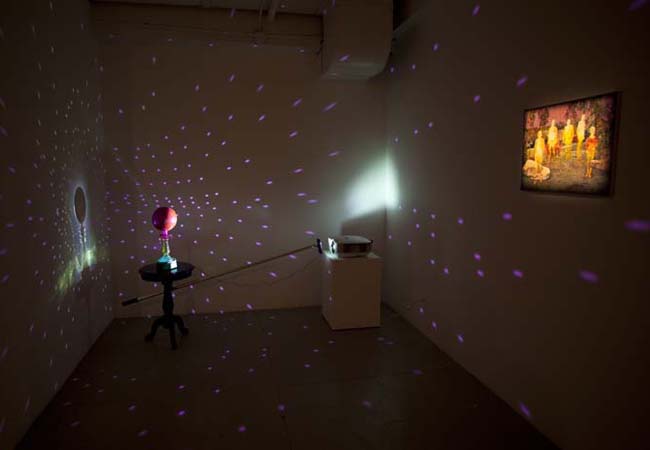 Richard Oliver Wilson, “Spare Time Continuum”; 2009; Installation; Dimensions variable
Richard Oliver Wilson, “Spare Time Continuum”; 2009; Installation; Dimensions variable
The Emo Show
Last year I walked into Thomas Lanigan – Schmidt’s exhibition “Tender Love Among The Junk” - mesmerized by the iconography and dazzling materials, I experienced awe, wonder, joy, mirth, and a flurry of other emotions that I feel when my temple is at it’s most resplendent for an auspicious ceremony. It was a liberating and singularly gratifying experience to encounter so much evocative work in a contemporary art exhibition. Growing up in India, the ethos of any work of music, dance, theatre, film, and art was crucial to its creation and reception, as Rasa theory continues to inform practitioners over twenty centuries. Rasa is a Sanskrit word that refers to the essence of an artwork that extends out if itself to affect its surroundings and the viewer. Viewed within this paradigm, a work of art becomes an act of psychic transference between the creator of piece and the one who encounters it.
Driven to see what an exhibition would look like if all the works were selected for their emotional impact, I asked several curators to work with me on this project – each curator brought their own personality to the table resulting in far richer selection of works than my singular vision could provide. The process of debating artworks collectively and discussing the predominant emotion in each felt like a refreshingly honest way to decide whether a particular work was to be included. My own choices of artworks reflect emotions that I am intimately familiar with – anger (Roberto Visani), melancholia (Ruby Chishti), laughter (William Villalongo) and joyful wonder (Richard Wilson). All of these artists recycle familiar objects infusing them with new meanings as sculptural forms.
Anger:
Roberto Visani’smultimedia sculptures take the form of guns – cast in metal and presented as modern tablets or fossils, or assembled out of broken and discarded items, they exude a charge that is undeniable. At once menacing and decorative, these sculptures radiate a complex range of anger fear, strength - the simultaneous attraction and revulsion we feel for something as powerful as a weapon. Roberto brings multiple references to his work, from his personal history, the American debate about gun control, the presence of guns in gangster culture and most importantly the history of individually manufactured, decorated and personalized weapons in West Africa as a means of self protection.
Sorrow:
There is a dark melancholia at work within Roberto’s weapons that finds an echo in Ruby Chishti’s soft sculptures. Presenting as small flocks of black crows fashioned out of recycled cloth and wire, these life size sculptures transport viewers to other, sadder, times and places. The crow becomes a symbol of longing and bittersweet nostalgia. Another sculpture by Ruby is a bulls head, fabricated from a sexy leather corset, cloth and horns. Ruby often uses the forms of domestic or animals familiar to South Asia to refer to patriarchal violence. Violence upon the female body then becomes a metaphor for larger societal violence. Ruby’s creations contain a pathos that epitomizes the rasa Karunayam – for compassion and tragedy.
Humor:
William Villalongo uses humor to unravel some of the same human complexities that are being examined in the works of Roberto and Ruby. Defusing the violence inherent in popular representations of blackness by inserting misplaced and absurd art historical references, William lightens and democratizes the esoteric language of art, while creating works that seduce then disarm you. Hyper sexualized female figures in his nymph paintings actively resist the viewer’s gaze, sticking up their middle finger while hiding behind a veil, maintaining an unexpected autonomy. In other sculptural works, incongruous combinations of found figurines of Indian and Egyptian gods are placed in slowly rotating discs that simulate UFO’s, - a curious and familiar mix of cultures, time frames and references.
Wonder:
Richard Oliver Wilson’s installation employs the logic of a closed circuit to generate a visual spectacle out of everyday objects. Using half the light from a projector to power a turntable and the other half to illuminate a slowly rotating mirror ball placed on a candlestick, Richard transforms a corner of the gallery into the vastness of space, complete with a total eclipse of the mirror ball, stars and galaxies floating across the walls. Revealing the process of generating the image takes nothing away from the sense of wonder experienced by the viewer when encountering the work. Pink dots float across the walls momentarily disappearing into smaller pink dots of an impressionist painting of characters from the television show Star Trek materializing out of space into an alien landscape. One of the rare works of art that evokes joy and wonder, this work speaks powerfully to the transformative potential of art.

* * * * * * * * * * * * * * *
Jaishri Abichandani, born in Bombay, India, immigrated to New York City in 1984. She intertwines art and activism in her career, founding the South Asian Women’s Creative Collective in New York and London. She has exhibited her work internationally at various venues including P.S.1/MOMA, the Queens Museum of Art, and Exit Art in New York, the 798 Beijing Biennial and the Guangzhou Triennial in China, India, Spain, and Berlin.
The Emo Show is on view at EFA Project Space through May 11, 2013